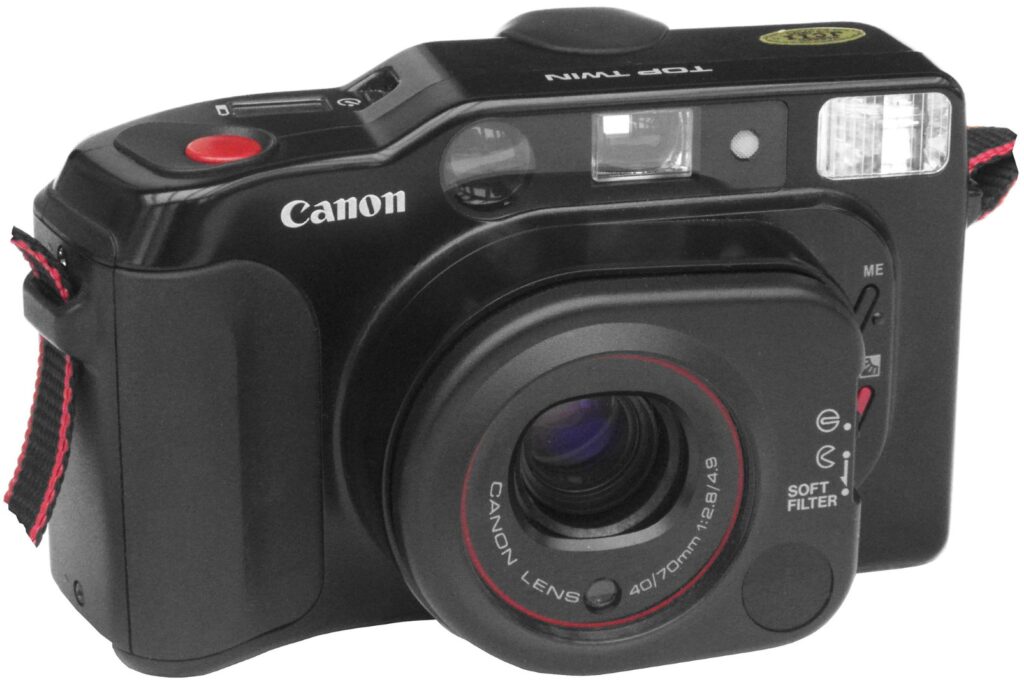
In the world of compact cameras, the Canon Top Twin remains an enduring classic. Depending on where you are in the world, you might recognize it as the Sure Shot Tele in America or the Autoboy Tele in Japan, it is part of Canons successful Sure Shot Series. Released in 1986, this camera captures the transition from classic film to the inklings of digital, making it an unforgettable piece in photography’s rich tapestry.
Design and Features
Sporting a unique design, the Canon Top Twin features a versatile dual-focal lens system. This provides photographers with two distinct choices: a 40 mm moderate wide-angle for capturing broader scenes, and a 70 mm telephoto lens for zooming into subjects, which extends noticeably when engaged. For those looking to accessorize, the lens offers a 40.5 mm thread.
One of the camera’s intriguing facets is a multi-functional switch on the lens barrel. Not only does it release the lens barrier, but it also activates a soft filter, adding a touch of finesse to portrait shots. Additional elements like the backlight compensation mode ensure your subjects are always perfectly lit, while the button for multiple exposures is a boon for creative souls. Dive deeper, and the multiple exposure mode can be paired with an optional trick filter, providing the tools to craft inventive composite exposures.
Film and Film Format
The Canon Top Twin accommodates DX coded films, available in the standard whole stops of 50, 100, 200, and 400. And for those moments when you have a non-DX coded film? The camera smartly defaults the exposure to ISO 100.
When it comes to film selection:
- General Photography: Kodak Portra 400 or Fujifilm Superia X-TRA 400 are versatile choices.
- Low Light Conditions: Kodak UltraMax 400 or the faster Ilford Delta 3200 can be a lifesaver.
- Landscapes: For colors that pop, nothing beats Fujifilm Velvia 50.
Power Source and Battery Life
Under the hood, the Canon Top Twin is powered by a robust 6V 2CR5 lithium battery. When the time comes for a replacement, arm yourself with a screwdriver. And for those who prefer hassle-free shopping, the essential battery can be conveniently purchased here on Amazon.
Exposure Control and Light Metering
Exposure can make or break an image. Thankfully, the Canon Top Twin excels with an auto-exposure range from EV 6–18. Whether you’re shooting wide or zooming in with the tele mode, the camera dynamically adjusts shutter speed and aperture for that perfect shot. Night or day, the built-in flash, adjustable through auto, off, or forced modes, ensures that lighting is never an issue.
Size, Weight, and Ergonomics
Balancing form and function, the camera tips the scales at a manageable 400 g. With dimensions of 134 x 78.7 x 61.8 mm, it’s compact enough for on-the-go photography while ensuring a comfortable grip and easy access to its features.
User Base: Beginners or Advanced Photographers?
The beauty of the Canon Top Twin lies in its universal appeal. Its intuitive design welcomes beginners, making photography a breeze. On the other hand, advanced photographers will relish exploring the depth of its features, from multiple exposures to creative filters.
Technical Specifications
| Feature | Specification |
|---|---|
| Wide-angle lens | 40 mm f/2.8, 4 elements in 3 groups |
| Tele lens | 70 mm f/4.9, 7 elements in 6 groups |
| Autofocus range | 0.96 m to infinity |
| Finder features | Focus confirmation and proximity warning |
| Auto-exposure (Wide) | 1/8 s ƒ/2.8 – 1/500 s ƒ/22 |
| Auto-exposure (Tele) | 1/3 s ƒ/4.9 – 1/350 s ƒ/27 |
| Built-in flash modes | Auto, off, forced |
| Flash range (ISO 100, Wide) | 5 m |
| Flash range (ISO 100, Tele) | 3 m |
Conclusion
The Canon Top Twin offers a straightforward and effective approach to photography. Its blend of features from the past with some modern conveniences makes it a reliable choice for those looking to experience film photography. Whether you’re a beginner or have been shooting for years, this camera provides a straightforward experience, making it a noteworthy addition to any photographer’s collection.
